|

|
|


|
|
If squatters are given tenure will others be encouraged to move to the cities?
Experience in the Philippines, Indonesia, India, Pakistan and Sri Lanka have shown that upgrading slums does not induce in-migration. By far the major factor inducing in-migration is the difference between rural and urban incomes and job opportunities. The next influence is facilities for better education. Better housing is a negligible factor. This has been shown by a number of international comparative socio-economic studies on migration. Some influx into slum areas (which are scheduled to be upgraded) by "professional squatters" who originate in other parts of the city sometimes occurs, but this can be avoided by organizing the community to protect their slum area and repel the in-comers. This was organized successfully in the Philippines, and to some extent in Karachi/Pakistan and Sri Lanka. |
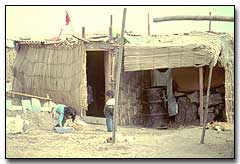
Lima, Peru.
Squatters are driven by job opportunities. |
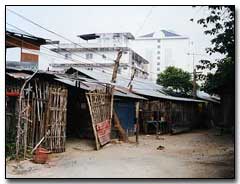
ChaingMai, Thailand.
A new arrival for a better life. |
Why should slum dwellers be given tenure on valuable land in a city which would be better used for commercial development?
This is an issue of equity and social justice. Most slum dwellers have lived in these areas for many years. Why should they be evicted in favor of rich developers and monied interests in the Government? If they wish to sell to private developers, that should be their choice and they should be able to reap the profits, based on market value, as with any other tenured landowner. History has shown that most slum dwellers prefer to stay in their locations. From the point of view of maintaining the vitality and social diversity of cities, this is, in fact a positive aspect. Experience in western cities where slum populations have been forcibly removed have shown that many of the city centers have declined into empty, crime-ridden 'mausolea.' Commercial developers can always find, and pay for, space for their developments. As recent experience in Asia has shown, cities are more in danger from commercial over-development than under-development! |
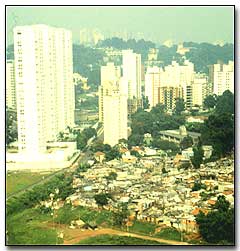
San Paulo, Brazil.
Who is encroaching? |
Why should single story or low rise upgrading be permitted on valuable central city land which could be developed to a higher density?
Most central city slum areas are already at a very high development density - often from 600 to 1800 persons/hectare. Most high-rise developments do not have a higher density than this. Moreover, slum areas maintain a high level of human/social activity (residential, commercial and industrial) at ground level - a situation which city managers and planners are now trying to re-create! The problem with most slum areas is nor their social and economic life, but their lack of environmental and social infrastructure and security of tenure. |
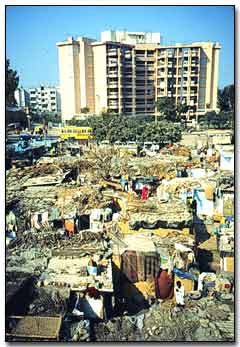
New Delhi, India.
Which has the higher density? |
If the slums are upgraded on private land, is public money being used to make the rich slumlords richer?
This is a genuine problem. Unless there is confusion in tenure rights such that people cannot easily be evicted (as in Indonesia), it is essential in most countries, for tenure rights to be transferred to the occupants at prices they can afford. This requires a measure of urban land reform. The Zonal Improvement Program, and the successful Community Mortgage program in the Philippines did this with good results. Occupants had to pay for their tenure rights whether they resided on government-owned or privately-owned land, and a method of land valuation and compensation to private land-owners was devised which was quite attractive to the private land-owners who could not, in any case sell their squatted land on the private market. |
Do slum dwellers use their own resources to improve their living conditions? Does public money need to be used?
Slum-dwellers do, indeed, use their own resources to improve their living conditions, provided they have security of tenure. No one, in their right mind, would put their own money into improving their house, if it, or the land under it was owned by someone else, who could at any time expropriate it! When security of tenure has been established, studies have shown that slum-dwellers will mobilize 2 to 4 times the amount of funds that the government has put into improving the infrastructure of a slum area. They will also often build additional dwelling units for rent, thus increasing the city's housing stock. Most public money put into slum-upgrading can be cost-recovered from the residents, and the low-cost approach and standards ensure that relatively little money is expended compared either to a fully-built housing program (which is often unaffordable) or to many other projects on which government money is spent which are less socially valuable. |
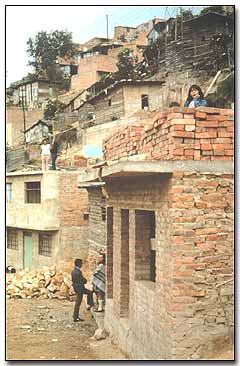
Bogota, Colombia.
A confident investment. |
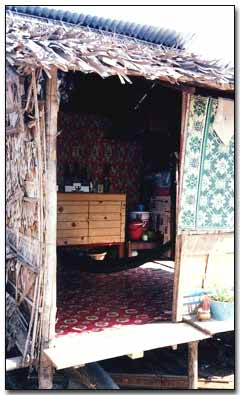
Phnom Penh, Cambodia.
Anticipation of the future. |
What is the value to the citizens who do not live in slums, when upgrading slums rather than demolishing them?
The value to the citizens is: i) they retain the wide range of low-cost services which they would be deprived of if slum-dwellers were moved out, ii) the central city retains its vitality, and iii) they avoid eventual ghettoization, social anomie and crime which follows most of the attempts to tear down unsightly areas and hide the poor. |
 |
 |
|
|






